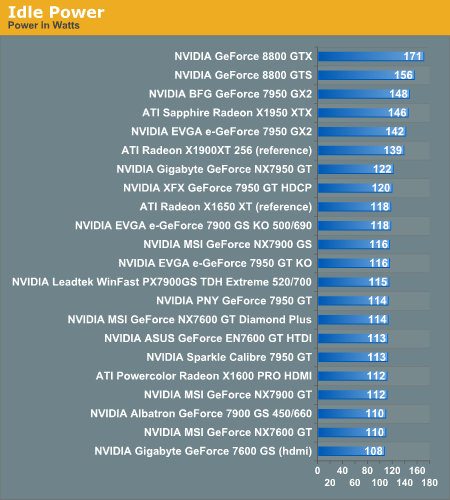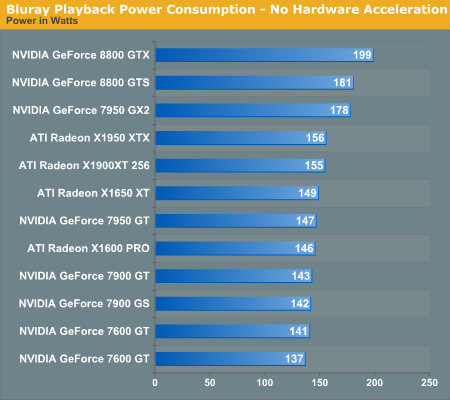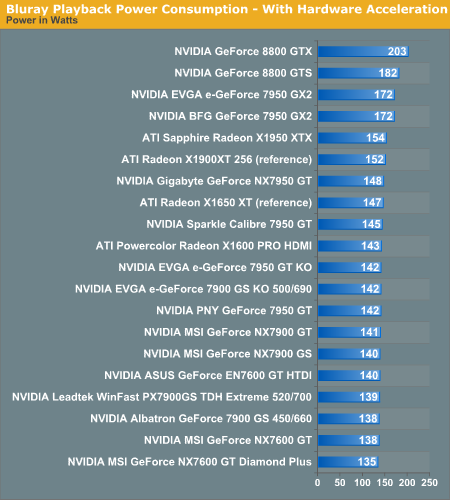NVIDIA and ATI HDCP Compatible Graphics Cards Roundup
by Josh Venning on November 16, 2006 12:00 AM EST- Posted in
- GPUs
Power
We regularly look at power consumption when talking about card performance, and for this review we want to look at two different aspects of power consumption. Since these cards all have potential for home theater systems given their HDCP compatibility, we want to look at not only power consumption during game performance, but also during BD video playback.
3D Acceleration Power Consumption
It's important to be aware of how much power your card draws when gaming so undue stress isn't put on your computer's power supply. Also, high wattage power supplies have bigger fans to keep them cool; that means a card with a lower power draw might be more desirable in a system that is built for as quiet operation as possible. To test the power load of these cards during 3D acceleration, we recorded the total wattage of the system with each of the cards installed while the system was idle for reference (i.e. no programs running), and then we recorded the total wattage of the system while running a few of the demos from 3DMark06. The 3DMark06 demos put stress on the GPU and we can then compare this to the idle wattage to get a general idea of how power hungry a card is.


We can see that as you would expect, higher performance cards like the Sapphire Radeon X1950 XTX as well as the EVGA and BFG GeForce 7950 GX2 saw some of the biggest power draws. The reference NVIDIA 8800 GTX required a bigger power supply than the one we used for the other cards, so we put in a more powerful one with the necessary two PCIe connectors for that particular configuration. This will make these power numbers less consistent with the others, but we can still get an idea of how power-hungry these new cards from NVIDIA are. These cards are going to require higher watt power supplies to run, and so might not be the best choice for a quiet system. We noticed that the Albatron 7900 GS had a lower power draw than the others in its class, and the Gigabyte 7600 GS was the least power-hungry of all of these cards (as well as the least effective in video decoding).
Blu-Ray Playback Power Consumption
We also want to look at power consumption while playing back a BD movie with these cards. Because 3D acceleration takes more processing power than decoding video, we will expect to see a lower power draw in these tests, but as with CPU utilization, we will probably be seeing higher power draws with future Blu-Ray and HD-DVD content which will make use of higher bitrate encoding.
We took power reading in the same way as with CPU utilization: by playing back about a minute of video from our Blu-Ray movie "Click." We are also interested in seeing the kinds of power loads these cards have when hardware acceleration is disabled in order to see the contrast between power loads. Because cards of the same family (i.e. 7900 GS, 7950 GT, etc.) saw very similar power consumption without hardware acceleration enabled, we only recorded power in this state for one of each card family. These are the results of our tests.


Again we see that not surprisingly, the higher performance cards see greater power draws than lesser performing ones, but we don't see a big difference here between most of the cards. In many cases, higher clocked cards of the same type see a little higher power draws than their competitors, but in some cases (like with the Leadtek WinFast PX7900 GS TDH Extreme) we see lower power draws. This tells us that there will be variation in power draw between cards of the same type depending on what types of modifications the different vendors make to their cards. Again keep in mind that we used a different power supply for the NVIDIA GeForce 8800 GTX, so it's not really an apples-to-apples comparison.
In the future, we could see power consumption go down with acceleration enabled. As graphics hardware is better suited to processing video than a CPU, efficiency should go up when using hardware acceleration. At this point, there isn't much difference, but this could change when we move away from MPEG-2 and into higher bitrate content.
We regularly look at power consumption when talking about card performance, and for this review we want to look at two different aspects of power consumption. Since these cards all have potential for home theater systems given their HDCP compatibility, we want to look at not only power consumption during game performance, but also during BD video playback.
3D Acceleration Power Consumption
It's important to be aware of how much power your card draws when gaming so undue stress isn't put on your computer's power supply. Also, high wattage power supplies have bigger fans to keep them cool; that means a card with a lower power draw might be more desirable in a system that is built for as quiet operation as possible. To test the power load of these cards during 3D acceleration, we recorded the total wattage of the system with each of the cards installed while the system was idle for reference (i.e. no programs running), and then we recorded the total wattage of the system while running a few of the demos from 3DMark06. The 3DMark06 demos put stress on the GPU and we can then compare this to the idle wattage to get a general idea of how power hungry a card is.


We can see that as you would expect, higher performance cards like the Sapphire Radeon X1950 XTX as well as the EVGA and BFG GeForce 7950 GX2 saw some of the biggest power draws. The reference NVIDIA 8800 GTX required a bigger power supply than the one we used for the other cards, so we put in a more powerful one with the necessary two PCIe connectors for that particular configuration. This will make these power numbers less consistent with the others, but we can still get an idea of how power-hungry these new cards from NVIDIA are. These cards are going to require higher watt power supplies to run, and so might not be the best choice for a quiet system. We noticed that the Albatron 7900 GS had a lower power draw than the others in its class, and the Gigabyte 7600 GS was the least power-hungry of all of these cards (as well as the least effective in video decoding).
Blu-Ray Playback Power Consumption
We also want to look at power consumption while playing back a BD movie with these cards. Because 3D acceleration takes more processing power than decoding video, we will expect to see a lower power draw in these tests, but as with CPU utilization, we will probably be seeing higher power draws with future Blu-Ray and HD-DVD content which will make use of higher bitrate encoding.
We took power reading in the same way as with CPU utilization: by playing back about a minute of video from our Blu-Ray movie "Click." We are also interested in seeing the kinds of power loads these cards have when hardware acceleration is disabled in order to see the contrast between power loads. Because cards of the same family (i.e. 7900 GS, 7950 GT, etc.) saw very similar power consumption without hardware acceleration enabled, we only recorded power in this state for one of each card family. These are the results of our tests.


Again we see that not surprisingly, the higher performance cards see greater power draws than lesser performing ones, but we don't see a big difference here between most of the cards. In many cases, higher clocked cards of the same type see a little higher power draws than their competitors, but in some cases (like with the Leadtek WinFast PX7900 GS TDH Extreme) we see lower power draws. This tells us that there will be variation in power draw between cards of the same type depending on what types of modifications the different vendors make to their cards. Again keep in mind that we used a different power supply for the NVIDIA GeForce 8800 GTX, so it's not really an apples-to-apples comparison.
In the future, we could see power consumption go down with acceleration enabled. As graphics hardware is better suited to processing video than a CPU, efficiency should go up when using hardware acceleration. At this point, there isn't much difference, but this could change when we move away from MPEG-2 and into higher bitrate content.










48 Comments
View All Comments
JarredWalton - Thursday, November 16, 2006 - link
Testing was done with an HDTV, because that's almost guaranteed to get HDCP support these days. Some of the newer LCDs have HDCP support (Dell's 2407 and 2007 do I believe), but most do not. That should change, but for now you are less likely to get HDCP with a standard PC display than with an HDTV. So, for HTPCs, you're better off getting just about any LCDTV or plasma in my opinion - watch out for projection HDTVs, as the text for PC use can get pretty garbled. Also beware of plasma burn-in possibilities. My rear-projection HDTV has a bit of burn-in already, and no matter what companies may say, plasma as I understand it is far more prone to such problems. (ESPN HD's logo is burned in on my TV, in case you want to know.)For the cards, features and performance are the two big factors - do you want gaming + HDCP support, just HDCP, or somewhere in between? What about HDMI? If you plan on connecting directly to a TV and using the TV speakers, you'll want HDMI that can include audio (several of the cards reviewed do this). My HDTV for example has an HDMI port, and I can use a DVI-to-HDMI cable to connect to it via just about any modern GPU. The problem is, I can't get audio from the TV without a true HDMI connection.
Finally, OS support is either via Vista, or else you can get an appropriate media player that will handle HDCP content. Testing here was done on XP, so it works already. Will Vista make it better? I personally doubt it, but it won't require extra software apparently (beyond whatever Vista already includes, of course, which is already a lot of "extra").
This article is more intended as an introduction to HDCP cards rather than being the final word. It will become more important over the next year or two, certainly. We'll have discussions on displays and HDCP support in the future.
DerekWilson - Friday, November 17, 2006 - link
Might I also add that 1080p HDTVs seem to make excellent computer monitors. If you want something to do dual duty as a TV and a PC monitor, I can highly recommend a 1080p LCD like the westinghouse we used in this review.If I had the money for either a new monitor or a new TV I'd go with one of these and kill two birds with one stone. And I'd be very very happy about it.
Tujan - Thursday, November 16, 2006 - link
Come on man.Desktop HD "? Smack some of that power onto those 32 to 40 in LCD sets. I know,I know,the angle is just around the corner. The LCD vendors are going have to,sooner,or later realize what their sets mean to the market.The market different from what is being portrayed. And what performance of them mean in it.Has there been any consideration of this.? And in doing so is there any caveats to using the HDTVs when involved with the drivers/hardware..there probably are. Since HDTV sets have somewhat sutured chipsets involved with them.
So in so doing,the idea here for HDCP,being that most of these cards have DVI(HDMI transformer connector)- problems/caveats for proper sound output was not considered. What to look for to consideration of other components,and compatability to HDCP.
Perahps for example I want to look at HD.And HDCP,are we going to limit our computers to a non-player in this area.For example,get on the wire-less keyboard in the living room already.
If I was to realize that electronics stores for example had 'none'of these HDCP enable cards I would be fixing some faces.
But BD,or HD-DVD on the computer screem ?
Come on man. Its chow on those 32",40" LCD HDTV monitors already.
As if Tiawan,Japan,South Korea aren't already in the weeds.I mean helloo.
And AMD-ATI,...-dont be such a lard bottom.!(AMD-ATI).
I mean(Anandtech) easily,get Fries,or Bestbuy to give you the keys to those isles for a night or two.Im sure they'd appreciate your tender convention.
thanks for ability to post here.And good article.
DigitalFreak - Friday, November 17, 2006 - link
Damn dude. I didn't understand a thing you said. Was that Far Eastern Jive or something?Tujan - Friday, November 17, 2006 - link
Here is the test setup page..http://www.anandtech.com/video/showdoc.aspx?i=2874...">http://www.anandtech.com/video/showdoc.aspx?i=2874...
Guess depends on where your standing (and punn ya yes):
-In front of the HDTVs or Video Cards
(retail electronics shop)
- At your work desk putting a computer together (or bench)
- At your desktop reading the Anandtech article....,or In your living room sitting at your couch.
- Maybe looking at your checkbook wondering that you dont 'want to afford a 500$ mistake.
............................
"Far East Jive" ? LOL. Its all Taiwan,Japan,or South Korea making the LCDs. They look really good.
It isn't like you cant see the jungle for the warefare.
________________
Just below here on a forum post the author you'll see that the Display was said to be an HDTV . Though the system stats didn't say "what<- ...uhumn .. Display.
Think that the point of the article was question of fact wether or not the video cards would have performance,and HDCP without sacrificing one or the other.Performance to gaming,and HDCP.
For me as I had first posted would be the testing of these stats/cards to the HDTV LCDs.The author,..again said later within this forum posted that other testing would take place.
Since the caveats against several different HDTV monitors would be exactly different than simply putting together the video card(s).Telling that everything was 'ok'by doing this.With HDTVs you would have to figure compatability via the video cards(to the HDTV) as well as HDTVs (to the video cards.)
This article did not go as far as testing against several HDTVs. With the different video cards(including interaction of software instalation).
The title of my post as 'toes in slippers..hmm". Bears the reasoning that against the backdrop of the 'shelf sets..HD DVD .. Blue-ray..and non-computer .. for the sake of broadcast,and 'media'- the living room LCDTVs are much more than this this.
Its not my business to tell anybody what their business is.Then when electronics vendors are going to ignore the accesories the LCD HDTVs afford to something as 'limited'as broadcast,and media. 'Broadcast,and HD,or Blueray to high definition is 'damn limiting.Thus the 'market'isn't what your being told it is. Just in case you hadn't noticed.
A 500$ mistake makes a difference.The context of that market is all about whats around the corner in so many ways. But where are you standing and whats there to look at ? If that market is ignored in the inventories and on the shelfs...as so on.In that 'limiting'focus.
Now,I've got to figure if my post is 'worth it'. The 32"and 40 LCDTVs are 'worth it. So lets see what they can do. Read some more angles about them before purchasing.
Thanks for reply.
Tarx - Thursday, November 16, 2006 - link
As mentioned above, but worth mentioning again, the X1950Pro is often considered to be the best midrange card currently on the market (relatively fast, not power hungry, fairly low cost, quiet, etc.) - if possible, can this article be amended to include it?DerekWilson - Friday, November 17, 2006 - link
As Josh mentioned above, ATI didn't support playback of HDCP protected content on the X1950 Pro until the release of the 6.11 Catalyst driver which was posted on 11/15/06 (one day before this article was published).We'll absolutely include the X1950 Pro in future articles that cover high definition video playback now that ATI has finally released a public driver for the same.
Spoelie - Thursday, November 16, 2006 - link
article index is broken (fixed)graphic card data is incorrect (x1900xt at 500/600 instead of 625/750? price?)
video table is f*cked up
oblivion settings are not linked (fixed now too)
etc. etc.
still a few cards i would like to see that are still missing, like a x1950pro with 512mb or the x1950xt - and what's the use of testing performance of identical cards, mentioning all hdcp compliant 7950gt and posting performance of one should be sufficient.
Spoelie - Thursday, November 16, 2006 - link
just to be clear, i know what the point is of this article, but since the x1950xt and a comparison between x1950pro 256/512 are both unlikely to get separate articles at this point, using roundups like this would be useful to include them, especially if you're gonna test and post 3d performance in the process :p so that we at least have some point of reference to make buying decisions. maybe something to note for future articles :)Josh Venning - Thursday, November 16, 2006 - link
Thanks for your comment.We did try to test the X1950 Pro for the HDCP review. Unfortunately, there hasn't been a public driver that supports the X1950 Pro since it's launch (that is until Catalyst 6.11 which was posted yesterday). ATI really dropped the ball with X1950 Pro, because the beta drivers they released did not support HDCP either.
We're sorry that we couldn't include this card in the review, but it just wasn't possible to test HDCP with the X1950 Pro until yesterday afternoon.